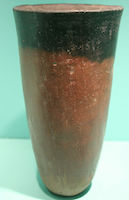Tarifian
At the sites of el–Tarif and Armant archaeologists found some remains pointing to an intermediate industry bridging the gap between Epipaleolithic and Neolithic cultures which was roughly contemporary with the Faiyum A culture of Lower Egypt. There is no evidence that this culture domesticated animals or farmed food, but it is difficult to be certain of this as the excavation of tombs during the New Kingdom all but destroyed any settlements in the area.
Badarian
Sites at El Badari (an El Matmar, El Etmanieh, El Hammamiya, and El Mostagedda) offer the first clear evidence of Neolithic industry in Upper Egypt. Located south of the Faiyum, on the eastern bank of the Nile, the Badari were a semi-nomadic people, who formed small settlements and began to cultivate grain and domesticate animals.
The exact chronological range of their culture is still debated. A period of 4400 to 4000 BC is certain, but they may have been established as early as 5000 BC. They were originally considered to have emerged from the south (in part because of their relatively simplistic tool use), but it is generally suggested that agriculture and animal husbandry originated not in the south, but in the east. It would seem likely that their origins are to be found in the Merimde culture of Lower Egypt and the Neolithic cultures of the Western Desert.



The culture was first identified by its characteristic pottery made from red Nile clay, often with a black interior and rim and a decorative rippled effect on the surface created by combing and polishing. Black beakers with incised decorations which were originally ascribed to an earlier culture labelled as Tasian are now considered to be imported goods from Sudan and the people of the Deir Tasa site are now considered to be part of the Badarian culture. Although their tools were fairly basic, the quality of the pottery is notable. In some cases the walls of the vessels are thinner than any other example from a predynastic site.

No remains of dwellings have been found, only storage pits and post holes suggestive of light structures perhaps made of reeds, skins, or mats. They farmed emmer wheat, barley, lentil, and flax and kept sheep, goats, and cattle. Fishing supplemented their diet, but there is little evidence of hunting. Copper awls and pins, steatite beads, shells, and turquoise found at Badari sites are thought to have been trade goods from the Red Sea and Palestine. However, it is possible that the Badarian people obtained their own copper and malachite , and the culture may have been more technically advanced than previously thought.
They buried their dead in small cemeteries on the outskirts of these settlements, and also conducted ceremonial burials for some of their domesticated animals. Pits were oval or rectangular. The body was generally interred in contracted position on the left side, facing west with the head to the south. A reed mat or hide was often placed over the body.
Although the graves themselves were simple, the deceased was buried with fine ceramics, jewellery, cloth and fur, and they sometimes included a finely crafted figurine of a female fertility idol and a cosmetic palette.
Trigger has described Badari culture as predominantly egalitarian with little social stratification. However, Bard, Hendrickx, and Vermeersch have challenged this view, pointing to the evidence of differing social status displayed by the grave goods found in the cemeteries at Armant and Nagada.
Bibliography
- Bard, Kathryn (2008) An introduction to the Archaeology of Ancient Egypt
- Bard, Kathryn (1999) Encyclopedia of the Archaeology of Ancient Egypt
- Brewer Douglas J. (2005) Ancient Egypt: Foundations of a Civilization
- Brewer Douglas J. (2012) The Archaeology of Ancient Egypt: Beyond Pharaohs
- Grajetzki, W (2003) Burial Customs in Ancient Egypt
- Kemp, Barry J (1991) Ancient Egypt: Anatomy of a Civilisation
- Hendrickx. S, Vermeersch, P (2000) “Prehistory”, in The Oxford History of Ancient Egypt Ed I. Shaw
- Trigger, B.G, Kemp, B.J, O’Connor. D, Lloyd. A.B (1983) Ancient Egypt, A Social History
Copyright J Hill 2016